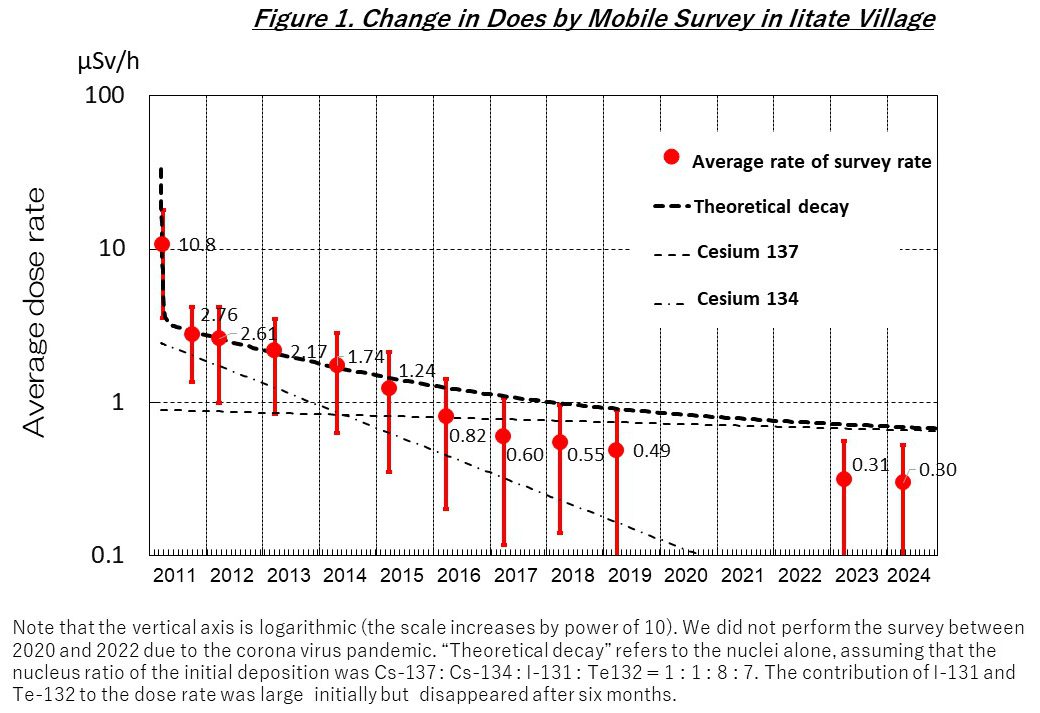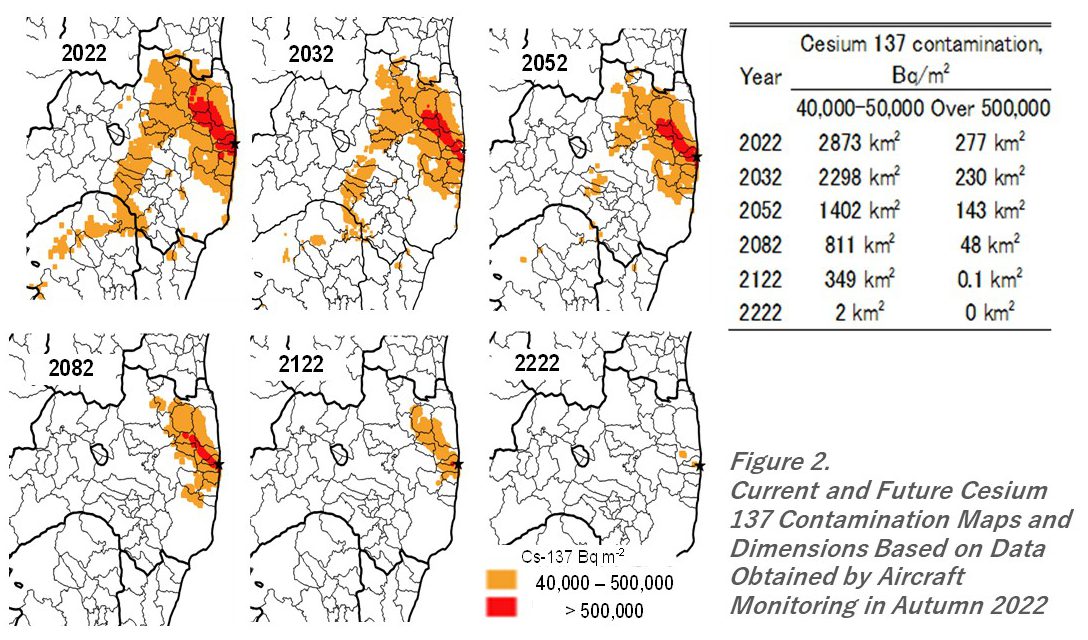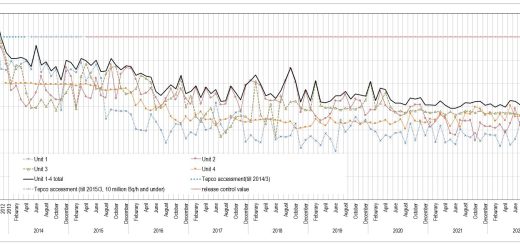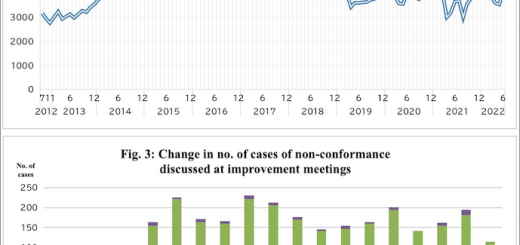Environmental Standards and Hazard Maps Are Required to Deal with Radioactive Contamination – Iitate Village Radiation Dose Survey Results and Contamination Forecasts
By Imanaka Tetsuji, Institute for Integrated Radiation and Nuclear Science, Kyoto University
Changes in dose rates in Iitate Village
Iitate Village lies in the Abukuma Highlands, 30 to 45 km northwest of the Fukushima Daiichi Nuclear Power Station (FDNPS). Its area is 230 km2, about four times as large as the area inside Tokyo’s Yamanote Line loop. About 75% of the village is covered with mountain forests. Before the 2011 FDNPS disaster, the village was home to about 1,700 households with a population of 6,200. The major industry was agriculture. About 15:00 on March 15, the indication of the portable radiation monitoring post, which was installed in a rush near the village office, started to rise, and reached its highest reading of 44.7 microsievert per hour (µSv/h) at 18:20. The rise was attributed to the radioactive plumes (clouds) that arrived over the village from FDNPS Unit 2, whose containment vessel was damaged at dawn on the 15th and started to leak great amounts of gaseous and volatile radioactive substances. The plumes reached the village by way of Futaba Town and Namie Town, most possibly carried by the northwestward winds that were blowing from before that time. Another unfortunate coincidence was that there was rainfall and snowfall when the radioactive plumes arrived over the village, resulting in tremendous ground depositions. The residents within the 20-km zone from FDNPS were directed to evacuate on March 12, when Unit 1 exploded due to hydrogen accumulation. On the other hand, the government designated highly contaminated areas outside the 20-km zone, such as Iitate Village, as “planned evacuation zones” on April 22, and directed residents to evacuate within about one month. Almost all Iitate residents evacuated before the end of July.
Our research team surveyed radioactive contamination in Iitate Village for the first time on March 29, 2011, 18 days after the March 11 occurrence of the FDNPS disaster.1) We drove a van along major roads around Iitate Village, parked at key spots, and measured air dose rates. In the Nagadoro district in the southern part of the village, the pocket-sized scintillation survey meter, which could measure up to 20 μSv/h, scaled out, and we switched to the ion chamber survey meter, which we brought along just in case. The maximum measurement was 30 μSv/h, which we obtained outside the car, in the rice paddies in the Magata area of the Nagadoro district. We sampled soil from the high-dose location and examined it back in our laboratory, traced the original composition of contaminant nuclei, and estimated that the dose rate on the March 15 evening, on which the radioactive deposition occurred, was about 200 μSv/h.
After the initial survey, we visited the village regularly to measure dose rates. Figure 1 shows the changes in average dose rates based on the values obtained by the mobile survey until April 2024.2)
Compared with 10.8 μSv/h in March 29, 2011 (130 locations), the average rate in April 13, 2024 (242 locations) was 0.30 μSv/h, which indicates a reduction to 1/36 th in the 13 years. The theoretical decay (dotted line) in Figure 1 represents the doses obtained in consideration of only physical decays of the radioactive nuclei, on the assumption that the initial deposition stayed where it was without moving. Up to 2014, the measurements and theoretical decay were consistent, but from 2015 to 2017, the measurements were smaller, which can be attributed to the large-scale decontamination conducted in those years. The natural dose before the disaster was 0.05 μSv/h, and the 2024 dose rates are six times as large. Considering that the current radioactive contamination consists mostly of cesium 137, whose half-life is 30 years, considerable contamination is expected to remain for about 100 years into the future.
Our survey measures the dose rates on decontaminated roads. However, the mountain forest area, which occupies 75% of Iitate Village, has only been decontaminated up to 20 meters from the roads. Contaminants thus remain as originally deposited. Each autumn, the Nuclear Regulation Agency conducts airborne monitoring over the areas contaminated by the nuclear disaster and releases the distribution of dose rates and contamination density in square mesh form of 250 meters square. According to the data for October 2022, the average dose rate in Iitate Village was 0.83 μSv/h, which is about three times as large as our measurements.3) Of the 3,623 mesh squares, 27% showed no less than 1 μSv/h, indicating that significant contamination remains in the forests.
Cesium 137 contamination map and future forecasts
In March 2011, as the seriousness of the Fukushima nuclear disaster was becoming apparent, military transport aircraft of the U.S. National Nuclear Security Administration (NNSA) survey team arrived at Yokota Base before dawn on March 16, carrying a great amount of equipment. On the next day, the 17th, the team began radioactive monitoring with the aircraft measurement system (AMS) in the vicinity of the FDNPS, using helicopters equipped with radiation monitors. The survey results were communicated to the Japanese government on the following day, but the government, seriously confused, could not make good use of the data.4) The NNSA’s contamination maps were released by the U.S. Department of Energy (DOE) on March 22, and reported by the Asahi newspaper on the 24th. The NNSA team continued the survey until the end of May, when the AMS was taken over by the MEXT (Ministry of Education, Culture, Sports, Science and Technology) and JAEA (Japan Atomic Energy Agency). Currently, the Nuclear Regulation Agency performs a periodical survey.
The Nuclear Regulation Agency’s (NRA’s) AMS equips a helicopter with a large-sized sodium iodide (NaI) monitor. The helicopter flies at about 300 meters from the contaminated ground surface at 160 km/h in straight lines, collecting gamma-ray spectrum data each second. The intervals between the straight aviation lines differ depending on the contamination level. In the 80-km zone from the FDNPS, the helicopter flies in intervals of 600 m to 1.8 km. Based on the airborne measurements, the NRA estimates air dose rates at a height of one meter from the ground surface (μSv/h) and contamination density (Bq/m2), disclosing values interpolated at the center points of individual mesh squares of 250 m square.
Figure 2 presents six cesium 137 contamination maps prepared based on the NRA’s AMS data for autumn 2022.5) The 2022 map was based on the actual data. The 2032 map represents an estimation for the area 10 years after 2022; the 2052 map, after 30 years; the 2082 map, after 60 years; the 2122 map, after 100 years; and the 2222 map, after 200 years.
These maps were created in consideration of the physical decay of the 30-year half-life of cesium 137. Concerning the coloring system, we decided on 40,000 becquerels per square meters (Bq/m2) based on the surface contamination criterion used to determine radiation control zones, and 500,000 Bq/m2 based on the mandatory relocation standard6) for people affected by the Chernobyl disaster. The table on the right side of Figure 2 shows changes of individual contamination levels in the areas. In most of the areas contaminated at the level of 500,000 Bq/m2 or higher, contamination will disappear in 100 years, as will the contamination in areas at 40,000 Bq/m2 in 200 years.
Full-of-loopholes “Act on Special Measures for Decontamination”
When the Fukushima nuclear disaster occurred, the legislation that regulated the handling of radioactive substances was the Act on the Regulation of Nuclear Source Material, Nuclear Fuel Material and Reactors, which is intended for nuclear power generation facilities; and the Act on the Prevention from Radiation Hazards (currently the Act on the Regulation of Radioisotopes), which is intended mainly for academic radioactivity facilities. Of course, accidents at nuclear power plants are in the scope of the former act. When radioactive contamination occurs in the vicinity of nuclear power facilities, the normal response procedure is to establish a temporary radiation control zone, which is lifted when the operator duly completes decontamination.
In April 2011, the areas where doses to people might exceed 20 millisievert per year (mSv/y) were designated as “planned evacuation zones.” However, while the Act on the Regulation of Nuclear Source Material, Nuclear Fuel Material and Reactors specifies that the public outside the nuclear site should not be exposed to more than 1 mSv a year, many areas more than 60 km away from the FDNPS, such as Fukushima City and Koriyama City, were contaminated beyond that limit. I was thinking that the Tokyo Electric Power Company (TEPCO) did not have the capabilities to take responsibility as the operator that caused the disaster and was wondering how the government could respond to this situation. Under such circumstances, the Act on Special Measures Concerning the Handling of Radioactive Pollution was established at the end of August 2011. A key point of this Act was the invention of the expression, “accident-derived radioactive substances,” separating FDNPS disaster-derived radioactive contamination from the control of the Act on the Regulation of Nuclear Source Material, Nuclear Fuel Material and Reactors. Conventionally, the waste from nuclear power facilities was “waste contaminated by nuclear fuel substances” (nuclear fuel contaminants), and the clearance contamination level below which the waste could be handled as nonradioactive waste was 100 becquerel per kilogram (Bq/kg). However, the Act on Special Measures Concerning the Handling of Radioactive Pollution states that if the contamination is no higher than 8,000 Bq/kg no special measures are required to handle the objects contaminated by disaster-derived radioactive substances and that the objects can be handled as normal waste.
According to the Act on Special Measures concerning the Handling of Radioactive Pollution, decontamination was conducted on a large scale from 2014 to 2016. From Iitate Village, more than two million flexible intermediate bulk container bags of waste resulted. The evacuation order was lifted from Iitate Village in March 2017 (excluding the Nagadoro district, which was designated as a difficult-to-return zone). About 1,200 villagers have returned since then. But in the mountain forests, which have not been decontaminated, high-level radioactive contamination still exists that exceeds the contamination level prohibited by the Act on the Regulation of Nuclear Source Material, Nuclear Fuel Material and Reactors and the Act on the Regulation of Radioisotopes. The Act on Special Measures Concerning the Handling of Radioactive Pollution is full of loopholes, allowing areas contaminated by radioactivity outside the scope of the decontamination work to remain as they were initially contaminated.
We require environmental standards for protection from radioactive contamination
The most primary legislation that controls environmental contamination is the Basic Environmental Law established in 1993. Article 16 of the law specifies: “With regard to the environmental conditions related to air pollution, water pollution, soil contamination and noise, the Government shall respectively establish environmental quality Standards, the maintenance of which is desirable for the protection of human health and the conservation of the living environment.”
Based on the Basic Environment Law, the Ministry of the Environment (MoE) has a Central Environment Council, in which subcommittees in charge of air, water quality, soil, etc. individually establish standard values, which the chairperson of the council reports to the Minister of the Environment. According to the MoE website, “those environmental standards are the administrative targets that should desirably be kept satisfied; we intend to maintain these as targets to be maintained through proactive efforts, not as the minimum requirements for retaining people’s health” (italicization by Imanaka).
To tell the truth, the Basic Environment Law included an article that excluded radioactive substances from the scope of the law before the FDNPS disaster in 2011, but in June 2012, the national assembly removed the article. In November 2012, the Central Environment Council submitted a recommendation to the Minister of the Environment, which stated: “Relevant laws and regulations should be promptly prepared and/or revised, and the procedures for establishing standards and control targets for radioactive substances should be individually examined.”
In response to this recommendation, the MoE released its perspective7) at the Central Environment Council in February 2015. Concerning nuclear power facilities, the MoE briefly stated that based on the policy of the International Commission on Radiological Protection (ICRP), nuclear sites control normal-state radioactivity in the environment through “justification, optimization and dose-limit application” and optimize protection according to the “reference level” when an abnormal condition results in environmental contamination, such that it is not necessary to establish standards for the general environment. The Central Environment Council seemingly approved of the ministry’s perspective by saying, namely, “no environmental standards are required for radioactive contamination.”
The dose limits are the maximum limits specified as permissible for the public and are not desirable targets. The “reference level” is the exposure up to which the administration decided to enforce the public to put up with when contamination occurs. Neither the dose limits nor the reference level are “desirable targets.” The Central Environment Council should establish environment targets as “desirable targets” in the true sense for radioactive contamination in Fukushima, in reflection of the spirit of the Basic Environment Law.
Environmental targets for radioactive contamination
I briefly explain how environmental standards are determined for chemical substances.8) Firstly, concerning the impact of the contaminant to be controlled, whether any threshold value (below which impacts are regarded as nonexistent) exists or not is examined based on literature data. For impacts regarded as having a threshold, a “nontoxic amount” is determined, and one hundredth of the “nontoxic amount” is normally used as the standard value. For impacts that have no threshold, doses and reaction models are examined instead, and the exposure level at which the lifetime risk of death will be 10-5 (one hundred thousandth) is regarded as the “virtually safe dose” and used as the standard.
When a substance is apparently carcinogenic, it is regarded having no threshold. Radiation and radioactive substances are classified into this category. In the attachment to the ICRP 1990 recommendation, when a person is exposed to a continuous dose of 1 mSv per year, the lifetime risk of death by cancer is estimated to be 4 × 10-3. Therefore, the exposure level that corresponds to a lifetime risk of 10-5 is 2.5 μSv per year, which is 1/400 of 1 mSv. A few days’ exposure to natural radiation reaches this dose.
Natural radiation cannot be avoided, and its strengths differ depending on the location; therefore, we should not insist on a risk of 10-5. By way of comparison, the U.S. Environmental Protection Agency (USEPA)’s regulation standard for the decontamination of the Hanford Nuclear Site may be useful; 0.15 mSv per year9). According to the USEPA, the lifetime risk at this level of exposure is about 3 × 10-4.
I believe that 0.1 mSv per year is the appropriate environmental control target for radiation, because the fluctuation width of natural radiation in Japan is 0.1 mSv per year (commensurate with 50,000 Bq/m2 in terms of cesium 137 contamination on the ground surface). The national and municipal governments should prepare color-coded hazard maps periodically to show contaminated areas in excess of the environment target (0.1 mSv per year) and dose limit (1 mSv per year) to enable people in the contaminated areas to avoid excess exposure.
Notes:
1) Survey Report 2011 (in Japanese), www.rri.kyoto-u.ac.jp/NSRG/seminar/No110/iitatereport11-4-4.pdf.
2) Survey Report 2024 (in Japanese), www.rri.kyoto-u.ac.jp/NSRG/temp/2024/Iitate24-4-13.pdf.
3) Proceedings (in Japanese).
www.rri.kyoto-u.ac.jp/NSRG/temp/2024/KEK2024_imanaka.pdf
4) Sawano Nobuhiro, Science Journal KAGAKU, Mar. 2017, Vol. 87, No. 3, Iwanami Shoten Publishers, available in Japanese at www.rri.kyoto-u.ac.jp/NSRG/etc/kagaku2017-3.pdf.
5) JAEA Radioactive Substance Monitoring Website (Radioactive Concentration-Deposition – Airborne Monitoring – Aircraft Monitoring 2022), emdb.jaea.go.jp/emdb/download
6) Obligatory relocation criterion for residents in the areas affected by the Chernobyl disaster was 550,000 Bq/m2.
7) The Central Environment Council document, 2015 (in Japanese) www.env.go.jp/council/01chuo/y010-22/mat03_3.pdf
8) Imanaka, T., Science Journal KAGAKU, Jun. 2021, Vol. 91, No. 6, Iwanami Shoten Publishers, available in Japanese at www.rri.kyoto-u.ac.jp/NSRG/temp/2021/Kagaku_202106_Imanaka.pdf
9) USEPA, 1997, semspub.epa.gov/work/HQ/176331.pdf.




